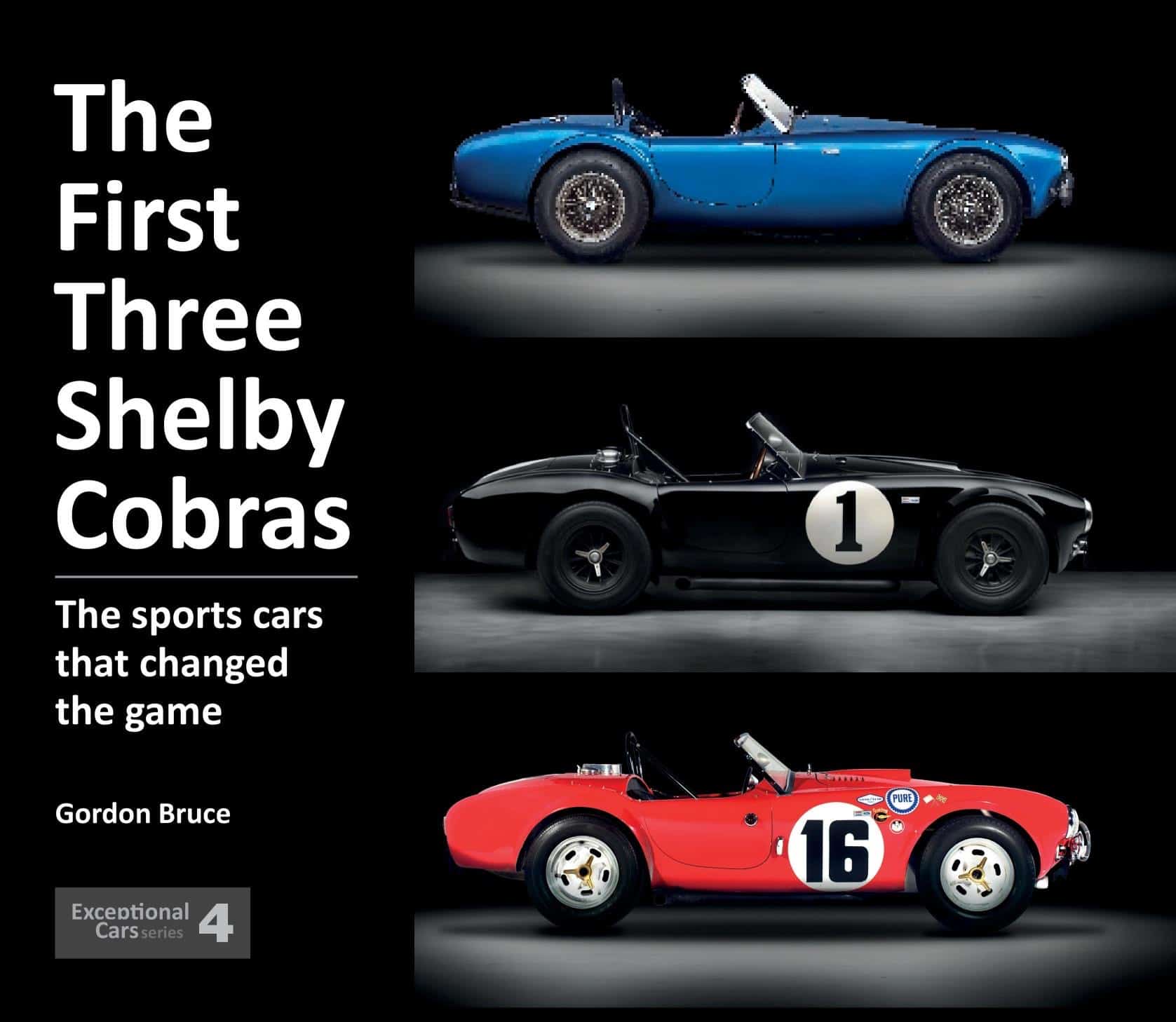Although their serial numbers are barely different — CSX2000, CSX2001 and CSX2002 — the first three Shelby Cobras drove to wildly divergent histories, and those cars and their stories, and the stories of the people involved in those histories, are the subjects of Gordon Bruce’s wonderfully told story of The First Three Shelby Cobras: The sports car that changed the game.
Actually, the cars not only were driven to different fates, each was launched from a different place once the bodies were shipped from AC Cars in England. CSX2000 was the original prototype and underwent final assembly in Carroll Shelby’s corner of Dean Moon’s hot-rod shop in Santa Fe Springs, California. CSX2000 also was the only Cobra equipped with inboard rear brakes.
CSX2001 was the first production Cobra, with its final assembly done at European Cars in Pittsburgh. It also was the first Shelby Cobra to be raced, albeit without consent from Carroll. CSX2001 would spend much of its life in Europe.
CSX2002 was the first “works” race car, shipped from Pittsburgh not to a Ford dealer east of the Mississippi but to Shelby’s own workshop for use by the Shelby American team, and later by a succession of Canadian racers.
You may not be able to afford a Cobra, but if you’re a fan, you cannot afford not to add this book to your library.”
All three cars were produced with leaf-spring suspension, Bishop worm-and-sector steering and Ford’s 260cid Windsor small-block V8 engine, though that powerplant was quickly replaced by a 289 in CSX2001.
Fascinating factoid: Bruce, an engineer and former road test editor of Motor magazine, notes that the basics of the Cobra chassis trace to an unlikely source — the Fiat Topolino of the 1930s. In 1946, John and Charles Cooper borrowed suspension parts from a crashed Topolino to create their F3 racer, and the setup also was used on their F1 racers and in Shelby’s Cobra.
Bruce also doubts the oft-told tale of how, to make people think there was more than just one car, Shelby reportedly had CXS2000 repainted each time it was photographed for a magazine cover over the course of a five-month period. The car originally was unveiled in unpainted aluminum, Bruce notes, and then was painted pearlescent yellow for the New York auto show. When it sold for $13.5 million at auction in 2016, it was covered in a metallic blue paint, and “completely unrestored,” though not without a war wound or two, “one of which has revealed a large square of a different hue below the blue,” Bruce reports. “It is not red, green or any of the other shades supposedly used at one time or another, but yellow, as seen in New York back in April 1962!”
CSX2001 was one of 19 early Cobras assembled at Ed Hugus’ European Cars facility in Pennsylvania (Bruce notes that Hungus, a 10-time Le Mans racer, actually funded the first seven cars until Shelby secured underwriting from Ford.)
To Shelby’s displeasure, Hugus took the car to a makeshift race track at the Connellsville Airport, where he quickly discovered the AC Ace radiators insufficient for cooling the Ford V8. Hugus soon sold the car to a psychiatrist who also was an amateur racer, but a blown tire at speed reportedly freaked out the shrink, and a deal was brokered by “Lucky” Casner and his Camoradi racing team for the car to be sold to a French airline pilot, Jean Marie Vincent, an experienced racer who entered the car in the 1964 24 Hours of Le Mans and almost immediately began a series of modifications to produce more power and more grip, and even an elongated targa-type roof.
The car also took part in the Tour de France and other events, at one point suffered an engine fire, at another was rebuilt using parts from two other Cobras, went through a series of colors, and finally, after being purchased at auction in 2006, was returned to the United States and repainted again, this time in black.
CSX2002 was driven by Bill Krause, Dan Gurney, Ken Miles and Dave MacDonald before being sold to Ford of Canada and assigned to Comstock Racing and driver Eppie Wietzes. The later went to Jean Ouellet and Rimouski Racing and others. In the late 1970s, the car was found in dismal condition in Massachusetts by Michael Shoen, future author of The Cobra-Ford Wars: 1963-1965, who had it restored and, in the early 1980s, put Bill Krause, its first driver, back behind the steering wheel for a race at Riverside.
Bruce’s book also includes sidebars on various people involved in the three cars’ histories (including their current ownerships), photo galleries of each vehicle, and a chapter on the later development of the Cobra brand.
The tales are well-told, and nicely illustrated. You may not be able to afford a Cobra, but if you’re a fan, you cannot afford not to add this book to your library.
Reviewed
The First Three Shelby Cobras: The sports car that changed the game
By Gordon Bruce
Porter Press International, 2018
ISBN 978-1-907085-55-0
Hard cover, 128 pages
$50





